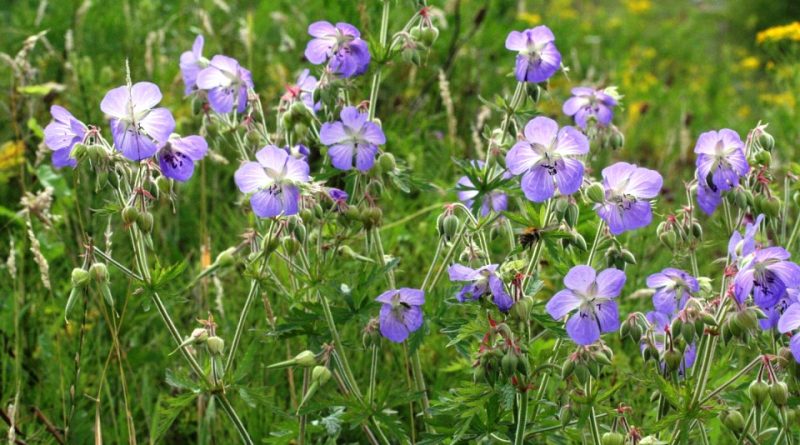Geranium pratense
Geranium pratense
The Meadow Crane’s Bill or meadow geranium, (Geranium pratense L.) is a perennial herbaceous species belonging to the Geraniaceae family.
Systematics –
From a systematic point of view it belongs to:
Eukaryota Domain,
Kingdom Plantae,
Subarign Tracheobionta,
Spermatophyta superdivision,
Magnoliophyta Division,
Magnoliopsida class,
Subclass Rosidae,
Order Geraniales,
Geraniaceae family,
Genus Geranium,
G. maculatum species.
The terms are synonymous:
– Geranium acknerianum Schur;
– Geranium aconitifolium var. album B.Ghosh & U.C. Bhattach .;
– Geranium alpinum Kit. Ex Kanitz;
– Geranium batrachioides Cav .;
– Geranium bicolor hort .;
– Geranium kemulariae Kharadze;
– Geranium mariae Sennen;
– Geranium napellifolium Schur;
– Geranium pseudoaconitifolium var. album (B.Ghosh & U.C. Bhattach.) Aswal & Mehrotra;
– Geranium rovirae var. purpureum Sennen;
– Geranium rovirae Sennen;
– Geranium sylvaticum batrachioides (Cav.) Graebn .;
– Geranium sylvaticum subsp. batrachioides (Cav.) Pers .;
– Geranium sylvaticum var. batrachioides (Cav.) DC .;
– Geranium sylvaticum var. batrachioides (Cav.) Steud .;
– Geranium valde-pilosum Schur;
– Geranium variegatum Wender. ex Steud ..
Etymology –
The term Geranium comes from the Greek γεράνιον gheranion geranium in Dioscorides, derived from γέρανος ghéranos gru: due to the fruits similar to the beak of cranes.
The specific Prato epithet comes from prátum prato, of the meadows: in reference to the growing environment.
Geographic Distribution and Habitat –
The Meadow Crane’s Bill is a plant native to the Altai mountains of central Asia and present in Europe and Asia, with wide distribution, and cultivated and naturalized elsewhere.
In Italy it is mainly present throughout the Alps (doubtfully in Val d’Aosta) and on the Tuscan-Emilian Apennines.
Its habitat is that of mowable meadows and at the edge of the woods, on fresh soils generally humid and rich in humus, neutral or alkaline, with optimum in the mountain belt between 500 and 1300 m a.s.
Description –
Geranium pratense is a perennial, herbaceous plant, with erect, pubescent, branched stems with dichotomous bifurcations.
The leaves are palmato-matched with acute, basal and cauline lobes are deeply divided into 5-9 sharp, incised-toothed lobes, the radical ones are broad and developed. The caulines are opposite and smaller towards the top.
The flowers are radiated symmetry, have a blue-violet to pink corolla, sometimes almost white, with 2 cm petals with the bottom drawn by darker veins. They have 5 trinerval lanceolate sepals with terminal mucron, 5 obovate petals and an upper ovary surrounded by 10 stamens welded to the base.
The ovary gives rise to capsules which at maturity separate into 5 achenes.
The fruit is a polachenary folded down, 34-36 mm long with mericarps of 4-6 x 2.5-3 mm, smooth or with 1-2 transversal roughnesses at the apex, hairy base, 21-29 mm rostrum. Reticulated seeds of 3-3.5 x 2 mm, reddish, with the hilum of 1/3 of the perimeter.
Cultivation –
The meadow geranium is an extremely hardy plant to at least -20 ° C, reflecting its origins.
This plant grows in any moderately fertile soil in a sunny location. Over time, many varieties have been selected for their ornamental value.
Propagation can take place both by seed and by division of tufts.
Sowing is done in spring, in a cold greenhouse, and then transplanting the plants already grown in pots or flower beds.
The division can be carried out both in spring and in autumn. Larger tufts can be replanted directly into their permanent locations, although smaller ones are best placed and grown in a cold greenhouse until they root well, then transplanted in the spring.
Customs and Traditions –
Meadow Crane’s Bill, like other geraniums, has a high tannin content and provides important astringent remedies.
It is an anti-inflammatory, analgesic, febrifuge and vulnerary plant.
The root is widely used in Tibetan medicine where it is said to have a sour, sweet taste plus a refreshing potency.
Preparation Method –
The root of this plant is mostly used in its areas of origin for analgesic, anti-inflammatory and febrifugal purposes; it is used in the treatment of flu fevers, inflammation of the lungs, pain and swelling of the limbs.
Guido Bissanti
Sources
– Acta Plantarum – Flora of the Italian Regions.
– Wikipedia, the free encyclopedia.
– Useful Tropical Plants Database.
– Conti F., Abbate G., Alessandrini A., Blasi C. (ed.), 2005. An annotated checklist of the Italian vascular flora, Palombi Editore.
– Pignatti S., 1982. Flora of Italy, Edagricole, Bologna.
– Treben M., 2000. Health from the Lord’s Pharmacy, Advice and experiences with medicinal herbs, Ennsthaler Editore.
Warning: Pharmaceutical applications and alimurgical uses are indicated for informational purposes only, they do not in any way represent a medical prescription; therefore no responsibility is taken for their use for curative, aesthetic or food purposes.


